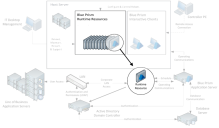Blue Prism runtime resource
Blue Prism runtime resource
Blue Prism runtime resources are persistent, typically virtualized, instances of standard end-user desktops running automated processes within a secure environment.
The key features of runtime resources are that they:
- Are centrally controlled.
- Execute assigned processes.
- Connect to the line of business application(s).
- Capture log information (which is then stored in the Blue Prism database).
Blue Prism runtime resources effectively operate a device as if a human operative was working it. Explicitly this means that the runtime resources must be logged in for processes to run, and furthermore, each transaction that is processed would be visible if a screen was connected. This guide contains a number of considerations to mitigate any potential security and governance concerns that this may raise.
Minimum requirements: runtime resources
The latest information about the minimum specifications of each Blue Prism component can be found in Blue Prism software and hardware requirements.
All minimum requirements must consider the selected operating system as well as the applications to be automated.
Runtime resources are typically deployed to virtualized instances of standard end-users desktops.
Each runtime resource requires the Blue Prism application to be installed. Consideration should be given to the installation of and connectivity to target applications; and access must be granted to all in-scope applications.
Additionally there are a number of settings and profile configurations that need to be applied. See the following sections for information.
Frequently asked questions: runtime resources
What are the security implications of this component?
As the runtime resources are responsible for executing the automated processes their security is paramount. The Physical Security section contains further information on this topic.
Can a single runtime resource be used across multiple environments?
Whilst it is possible to reconfigure a runtime resource to be connected to a different environment, provided they are running the same version of Blue Prism, it is not recommended to frequently switch which environment a specific runtime resource is assigned to.
Does this component need to be backed up?
Typically there is no important information or configuration stored on a Blue Prism runtime resource. It is however recommended that where possible, a clone of the desktop should be retained, and consideration given to whether any of the runtime resources are used for business critical processing.
Networking: runtime resources
The main components that runtime resources initiate communications with include:
- Application server– The application server is used for all database connectivity (WCF). In addition, commands the runtime resources to execute processes come from the application server over a TCP connection. This is referred to as Application Server Controlled Resources (ASCR).
- Third-party applications – The type of connectivity required between the runtime resources and third-party applications will depend on the nature of the automation. The majority of Blue Prism automation takes place via the GUI and therefore the runtime resources simply need the same level of access as a typical end-user of the given application. Where deeper connections (e.g. direct database, web service, message queues) are required the appropriate ports and access will need to be configured.
- Browser extensions – Native support for automating web pages and applications in Google Chrome, the Chromium-based version of Microsoft Edge, and Mozilla Firefox web browsers is provided using Blue Prism browser extensions. The extensions allow Blue Prism to interact with web pages and applications presented in these browsers, so that business processes that rely on such applications and web pages can easily be modeled.




No comments